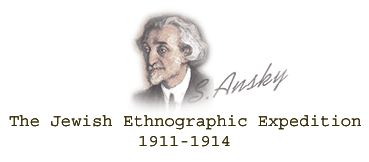|

The Historical-Ethnographic
Society of St. Petersburg, which oversaw the ethnographic expedition led
by Ansky, was created in 1908 by several members of the St. Petersburg
Jewish community, including the philanthropist Moisei Akimovitch Ginsburg,
the celebrated Russian-Jewish historian Simon Dubnow, and Ansky. Its goal
was to gather, study, and analyze historical and ethnographic materials
about the Jews in Russia and Poland from the appearance of the first Jewish
settlements until the present day. It lasted until 1930.
 Jewish
Museum set up by Ansky, St. Petersburg
Jewish
Museum set up by Ansky, St. Petersburg |
The ethnographic expedition
was funded by Baron Vladimir Guenzburg, and included two specialists in
Jewish musical folklore, as well as the photographer and artist Solomon
Yudovin. The Expedition ended with the outbreak of World War I.
In 1916, Ansky set
up a museum to house the expedition's artifacts in a building at 50 Fifth
Liniya in St. Petersburg that contained the Jewish almshouse and several
Jewish cultural preservation organizations. There were about 1000 items
exhibited, including wax phonograph cylinders of folk songs; collections
of folklore; manuscripts, and old books; photographs of synagogues and
scenes from daily life; ritual utensils and objects; clothing; wedding
decorations; and tableware. The members of the expedition also wrote down
stories, histories, remedies, legends, sayings, and spells that were told
to them.
The museum was closed
around 1930, its exhibits divided and transferred to other museums. The
ritual objects were said to have gone to the Soviet Government Museum
of Ethnography in Leningrad (the name for St. Petersburg after the Russian
revolution), where some were exhibited, and they are still stored. The
museum's archives were sent to the Institute of Jewish Proletarian Culture
in Kiev. There is evidence that in 1938 a large portion of the items were
transferred to the Jewish Museum in Odessa, but their fate after the war
is unknown. In 1992, the collection from the Soviet Government Museum
of Ethnography was finally brought to the world outside Russia in a multi-national
exhibition that traveled to Amsterdam, Cologne, Frankfurt, Israel, and
New York City.
|
Tally
of Items gathered during the expedition:*
2,000
photographs
1,800 folktales and legends
1,500
folk songs and mysteries (i.e. biblical Purim plays)
500
cylinders of Jewish folk music
1,000
melodies to songs and niggunim without words
Countless
proverbs and folk beliefs
100
historical documents
500 manuscripts and books
700 sacred objects acquired for the sum of six thousand rubles
Sample
questions posed by the ethnographers to Jews they met during
the expedition
|
 |
*
From: David G. Roskies, ed. The Dybbuk and Other Writings.
Copyright © 1992 The Fund for the Translation of Jewish Literature
(New York: Schocken Books), p. xxiii. |
 |
Mikhail
Beizer, Michael Sherbourne trans. The Jews of St. Petersburg.
Philadelphia: The Jewish Publication Society, 1989, pp. 92-122.
Tracing An-sky: Jewish collections from the State Ethnographic
Museum in St. Petersburg 1992-1994. Exhibition catalog.
|
ANSKY
Introduction
|



